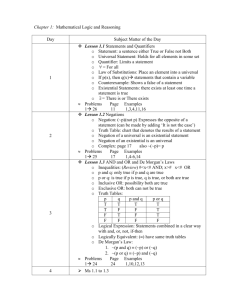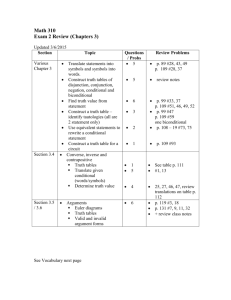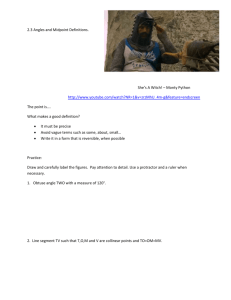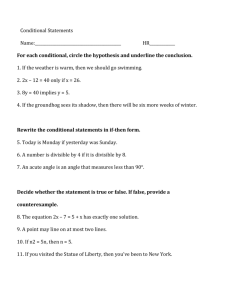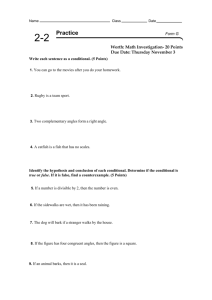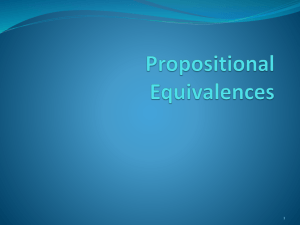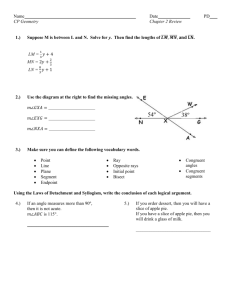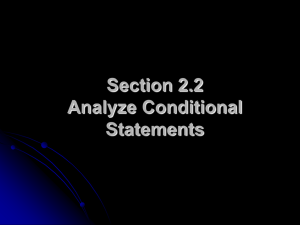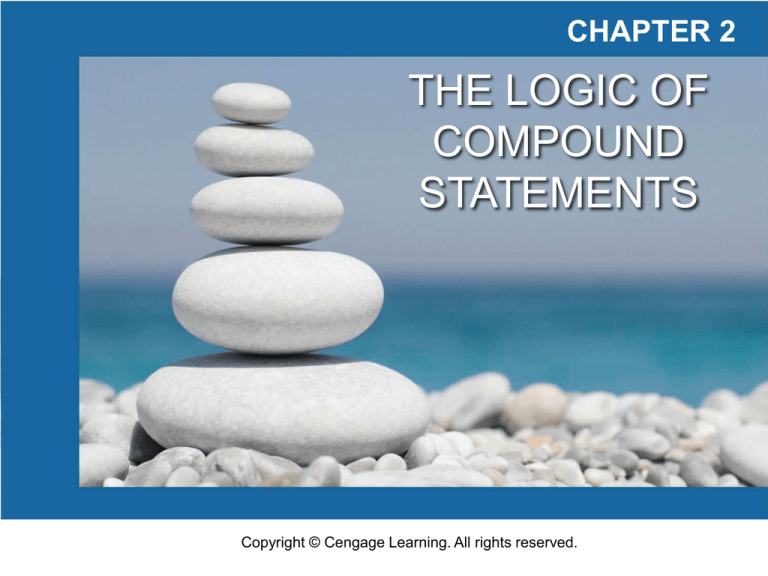
CHAPTER 2
THE LOGIC OF
COMPOUND
STATEMENTS
Copyright © Cengage Learning. All rights reserved.
SECTION 2.1
Logical Form and Logical
Equivalence
Copyright © Cengage Learning. All rights reserved.
Logical Form and Logical Equivalence
The central concept of deductive logic is the concept of
argument form. An argument is a sequence of statements
aimed at demonstrating the truth of an assertion.
The assertion at the end of the sequence is called the
conclusion, and the preceding statements are called
premises.
To have confidence in the conclusion that you draw from
an argument, you must be sure that the premises are
acceptable on their own merits or follow from other
statements that are known to be true.
3
Example 1 – Identifying Logical Form
Fill in the blanks below so that argument (b) has the same
form as argument (a). Then represent the common form of
the arguments using letters to stand for component
sentences.
a. If Jane is a math major or Jane is a computer science
major, then Jane will take Math 150. Jane is a computer
science major. Therefore, Jane will take Math 150.
b. If logic is easy or
, then
.
I will study hard.
Therefore, I will get an A in this course.
4
Example 1 – Solution
1. I (will) study hard.
2. I will get an A in this course.
Common form: If p or q, then r.
q.
Therefore, r.
5
Statements
6
Statements
Most of the definitions of formal logic have been developed
so that they agree with the natural or intuitive logic used by
people who have been educated to think clearly and use
language carefully.
The differences that exist between formal and intuitive logic
are necessary to avoid ambiguity and obtain consistency.
In any mathematical theory, new terms are defined by
using those that have been previously defined. However,
this process has to start somewhere. A few initial terms
necessarily remain undefined.
7
Statements
In logic, the words sentence, true, and false are the initial
undefined terms.
8
Compound Statements
9
Compound Statements
We now introduce three symbols that are used to build more
complicated logical expressions out of simpler ones.
The symbol ~ denotes not, denotes and, and denotes or.
Given a statement p, the sentence “~p” is read “not p” or “It is
not the case that p” and is called the negation of p. In some
computer languages the symbol is used in place of ~.
10
Compound Statements
Given another statement q, the sentence “p q” is read
“p and q” and is called the conjunction of p and q.
The sentence “p q” is read “p or q” and is called the
disjunction of p and q.
In expressions that include the symbol ~ as well as or ,
the order of operations specifies that ~ is performed first.
For instance, ~p q = (~p) q.
11
Compound Statements
In logical expressions, as in ordinary algebraic expressions,
the order of operations can be overridden through the use
of parentheses.
Thus ~(p q) represents the negation of the conjunction
of p and q.
In this, as in most treatments of logic, the symbols and
are considered coequal in order of operation, and an
expression such as p q r is considered ambiguous.
This expression must be written as either (p q) r or
p (q r) to have meaning.
12
Example 2 – Translating from English to Symbols: But and Neither-Nor
Write each of the following sentences symbolically, letting
h = “It is hot” and s = “It is sunny.”
a. It is not hot but it is sunny.
b. It is neither hot nor sunny.
Solution:
a. The given sentence is equivalent to “It is not hot and it is
sunny,” which can be written symbolically as ~h s.
b. To say it is neither hot nor sunny means that it is not hot
and it is not sunny. Therefore, the given sentence can be
written symbolically as ~h ~s.
13
Truth Values
14
Truth Values
In Example 2 we built compound sentences out of
component statements and the terms not, and, and or.
If such sentences are to be statements, however, they must
have well-defined truth values—they must be either true
or false.
We now define such compound sentences as statements
by specifying their truth values in terms of the statements
that compose them.
15
Truth Values
The negation of a statement is a statement that exactly
expresses what it would mean for the statement to be false.
The truth values for negation are summarized in a truth table.
Truth Table for ~p
16
Truth Values
The truth values for conjunction can also be summarized in
a truth table.
Truth Table for p q
17
Truth Values
Here is the truth table for disjunction:
Truth Table for p q
18
Evaluating the Truth of More
General Compound Statements
19
Evaluating the Truth of More General Compound Statements
Now that truth values have been assigned to ~p, p q, and
p q, consider the question of assigning truth values to
more complicated expressions such as ~p q,
(p q) ~(p q), and (p q) r. Such expressions are
called statement forms (or propositional forms).
20
Evaluating the Truth of More General Compound Statements
To compute the truth values for a statement form, follow
rules similar to those used to evaluate algebraic
expressions.
For each combination of truth values for the statement
variables, first evaluate the expressions within the
innermost parentheses, then evaluate the expressions
within the next innermost set of parentheses, and so forth
until you have the truth values for the complete expression.
21
Example 4 – Truth Table for Exclusive Or
Construct the truth table for the statement form
(p q) ~(p q).
Note that when or is used in its exclusive sense, the
statement “p or q” means “p or q but not both” or “p or q
and not both p and q,” which translates into symbols as
(p q) ~(p q).
This is sometimes abbreviated
22
Example 4 – Solution
Set up columns labeled p, q, p q, p q, ~(p q), and
(p q) ~(p q).
Truth Table for Exclusive Or: (p q) ~( p q)
Fill in the p and q columns with all the logically possible
combinations of T’s and F’s. Then use the truth tables for
and to fill in the p q and p q columns with the
appropriate truth values.
23
Example 4 – Solution
cont’d
Next fill in the ~(p q) column by taking the opposites of
the truth values for p q.
For example, the entry for ~(p q) in the first row is F
because in the first row the truth value of p q is T.
Finally, fill in the (p q) ~(p q) column by considering
the truth table for an and statement together with the
computed truth values for p q and ~(p q).
24
Example 4 – Solution
cont’d
The entry in the second row is T because both components
are true in this row.
Truth Table for Exclusive Or: (p q) ~( p q)
25
Logical Equivalence
26
Logical Equivalence
The statements
6 is greater than 2 and 2 is less than 6
are two different ways of saying the same thing. Why?
Because of the definition of the phrases greater than and
less than. By contrast, although the statements
(1) Dogs bark and cats meow
and
(2) Cats meow and dogs bark
are also two different ways of saying the same thing, the
reason has nothing to do with the definition of the words.
27
Logical Equivalence
It has to do with the logical form of the statements.
Any two statements whose logical forms are related in the
same way as (1) and (2) would either both be true or both
be false.
You can see this by examining the following truth table,
where the statement variables p and q are substituted for
the component statements “Dogs bark” and “Cats meow,”
respectively.
28
Logical Equivalence
The table shows that for each combination of truth values
for p and q, p q is true when, and only when, q p is true.
In such a case, the statement
forms are called logically
equivalent, and we say
that (1) and (2) are
logically equivalent
statements.
29
Logical Equivalence
Testing Whether Two Statement Forms P and Q Are
Logically Equivalent
1. Construct a truth table with one column for the truth
values of P and another column for the truth values of Q.
30
Logical Equivalence
2. Check each combination of truth values of the statement
variables to see whether the truth value of P is the same
as the truth value of Q.
a. If in each row the truth value of P is the same as the
truth value of Q, then P and Q are logically equivalent.
b. If in some row P has a different truth value from Q,
then P and Q are not logically equivalent.
31
Example 6 – Double Negative Property: ∼(∼p) ≡ p
Construct a truth table to show that the negation of the
negation of a statement is logically equivalent to the
statement, annotating the table with a sentence of
explanation.
Solution:
32
Logical Equivalence
There are two ways to show that statement forms P and Q
are not logically equivalent. As indicated previously, one is
to use a truth table to find rows for which their truth values
differ.
The other way is to find concrete statements for each of the
two forms, one of which is true and the other of which is
false.
The next example illustrates both of these ways.
33
Example 7 – Showing Nonequivalence
Show that the statement forms ~(p q) and ~p ~q are not
logically equivalent.
Solution:
a. This method uses a truth table annotated with a sentence
of explanation.
34
Example 7 – Solution
cont’d
b. This method uses an example to show that ~(p q) and
~p ~q are not logically equivalent. Let p be the
statement “0 < 1” and let q be the statement “1 < 0.”
Then
which is true.
On the other hand,
which is false.
35
Example 7 – Solution
cont’d
This example shows that there are concrete statements
you can substitute for p and q to make one of the
statement forms true and the other false.
Therefore, the statement forms are not logically
equivalent.
36
Logical Equivalence
The two logical equivalences are known as De Morgan’s
laws of logic in honor of Augustus De Morgan, who was
the first to state them in formal mathematical terms.
37
Logical Equivalence
Symbolically we can represent the two logic equivalences
as:
and
38
Example 9 – Applying De Morgan’s Laws
Write negations for each of the following statements:
a. John is 6 feet tall and he weighs at least 200 pounds.
b. The bus was late or Tom’s watch was slow.
Solution:
a. John is not 6 feet tall or he weighs less than 200 pounds.
b. The bus was not late and Tom’s watch was not slow.
Since the statement “neither p nor q” means the same as
“~p and ~q,” an alternative answer for (b) is “Neither was
the bus late nor was Tom’s watch slow.”
39
Example 11 – A Cautionary Example
According to De Morgan’s laws, the negation of
p: Jim is tall and Jim is thin
is
~p: Jim is not tall or Jim is not thin
because the negation of an and statement is the or statement
in which the two components are negated.
Unfortunately, a potentially confusing aspect of the English
language can arise when you are taking negations of this
kind. Note that statement p can be written more compactly as
p: Jim is tall and thin.
40
Example 11 – A Cautionary Example
cont’d
When it is so written, another way to negate it is
~(p): Jim is not tall and thin.
But in this form the negation looks like an and statement.
Doesn’t that violate De Morgan’s laws?
Actually no violation occurs. The reason is that in formal
logic the words and and or are allowed only between
complete statements, not between sentence fragments.
41
Example 11 – A Cautionary Example
cont’d
One lesson to be learned from this example is that when
you apply De Morgan’s laws, you must have complete
statements on either side of each and and on either side of
each or.
42
Tautologies and Contradictions
43
Tautologies and Contradictions
According to this definition, the truth of a tautological
statement and the falsity of a contradictory statement are
due to the logical structure of the statements themselves
and are independent of the meanings of the statements.
44
Example 13 – Logical Equivalence Involving Tautologies and Contradictions
If t is a tautology and c is a contradiction, show that
p t p and p c c.
Solution:
45
Summary of Logical Equivalences
46
Summary of Logical Equivalences
Knowledge of logically equivalent statements is very useful
for constructing arguments.
It often happens that it is difficult to see how a conclusion
follows from one form of a statement, whereas it is easy to
see how it follows from a logically equivalent form of the
statement.
47
Summary of Logical Equivalences
A number of logical equivalences are summarized in
Theorem 2.1.1 for future reference.
48
Example 14 – Simplifying Statement Forms
Use Theorem 2.1.1 to verify the logical equivalence
Solution:
Use the laws of Theorem 2.1.1 to replace sections of the
statement form on the left by logically equivalent
expressions.
Each time you do this, you obtain a logically equivalent
statement form.
49
Example 14 – Solution
cont’d
Continue making replacements until you obtain the
statement form on the right.
50
51
SECTION 2.2
Conditional Statements
Copyright © Cengage Learning. All rights reserved.
52
Conditional Statements
Let p and q be statements. A sentence of the form
“If p then q” is denoted symbolically by “p → q”; p is called
the hypothesis and q is called the conclusion. For instance,
consider the following statement:
Such a sentence is called conditional because the truth of
statement q is conditioned on the truth of statement p.
53
Conditional Statements
The notation p → q indicates that → is a connective,
like ∧ or ∨, that can be used to join statements to create
new statements.
To define p → q as a statement, therefore, we must specify
the truth values for p → q as we specified truth values for
p ∧ q and for p ∨ q.
As is the case with the other connectives, the formal
definition of truth values for →(if-then) is based on its
everyday, intuitive meaning.
54
Conditional Statements
Truth Table for p ↔ q
55
Conditional Statements
A conditional statement that is true by virtue of the fact that
its hypothesis is false is often called vacuously true or
true by default.
Thus the statement “If you show up for work Monday
morning, then you will get the job” is vacuously true if you
do not show up for work Monday morning.
In general, when the “if” part of an if-then statement is
false, the statement as a whole is said to be true,
regardless of whether the conclusion is true or false.
56
Example 1 – A Conditional Statement with a False Hypothesis
Consider the statement:
If 0 = 1 then 1 = 2.
As strange as it may seem, since the hypothesis of this
statement is false, the statement as a whole is true.
57
Conditional Statements
In expressions that include → as well as other logical
operators such as ∧, ∨, and ∼, the order of operations is
that → is performed last.
Thus, according to the specification of order of operations,
∼ is performed first, then ∧ and ∨, and finally →.
58
Example 2 – Truth Table for p ∨ ∼q → ∼p
Construct a truth table for the statement form p ∨ ∼q → ∼p.
Solution:
By the order of operations given above, the following two
expressions are equivalent: p ∨ ∼q → ∼p and
(p ∨ (∼q)) → (∼p), and this order governs the construction
of the truth table.
First fill in the four possible combinations of truth values for
p and q, and then enter the truth values for ∼p and ∼q
using the definition of negation.
59
Example 2 – Solution
cont’d
Next fill in the p ∨ ∼q column using the definition of ∨.
Finally, fill in the p ∨ ∼q → ∼p column using the definition
of →.
The only rows in which the hypothesis p ∨ ∼q is true and
the conclusion ∼p is false are the first and second rows.
So you put F’s in those two rows and T’s in the other two
rows.
60
Logical Equivalences Involving →
61
Example 3 – Division into Cases: Showing that p ∨ q → r ≡ ( p → r) ∧ (q → r)
Use truth tables to show the logical equivalence of the
statement forms p ∨ q → r and (p → r ) ∧ (q → r). Annotate
the table with a sentence of explanation.
Solution:
First fill in the eight possible combinations of truth values
for p, q, and r.
Then fill in the columns for p ∨ q, p → r , and q → r using
the definitions of or and if-then.
62
Example 3 – Solution
cont’d
For instance, the p → r column has F’s in the second and
fourth rows because these are the rows in which p is true
and q is false.
Next fill in the p ∨ q → r column using the definition of
if-then. The rows in which the hypothesis p ∨ q is true and
the conclusion r is false are the second, fourth, and sixth.
So F’s go in these rows and T’s in all the others.
63
Example 3 – Solution
cont’d
The complete table shows that p ∨ q → r and
(p → r) ∧ (q → r) have the same truth values for each
combination of truth values of p, q, and r. Hence the two
statement forms are logically equivalent.
64
Representation of If-Then As Or
65
Example 4 – Application of the Equivalence between ∼p ∨ q and p → q
Rewrite the following statement in if-then form.
Either you get to work on time or you are fired.
Solution:
Let ∼p be
You get to work on time.
and q be
You are fired.
Then the given statement is ∼p ∨ q. Also p is
You do not get to work on time.
So the equivalent if-then version, p → q, is
If you do not get to work on time, then you are fired. 66
The Negation of a Conditional
Statement
67
The Negation of a Conditional Statement
By definition, p → q is false if, and only if, its hypothesis, p,
is true and its conclusion, q, is false. It follows that
This can be restated symbolically as follows:
68
Example 5 – Negations of If-Then Statements
Write negations for each of the following statements:
a. If my car is in the repair shop, then I cannot get to class.
b. If Sara lives in Athens, then she lives in Greece.
Solution:
a. My car is in the repair shop and I can get to class.
b. Sara lives in Athens and she does not live in Greece.
(Sara might live in Athens, Georgia; Athens, Ohio; or
Athens, Wisconsin.)
69
The Contrapositive of a
Conditional Statement
70
The Contrapositive of a Conditional Statement
One of the most fundamental laws of logic is the
equivalence between a conditional statement and its
contrapositive.
The fact is that
71
Example 6 – Writing the Contrapositive
Write each of the following statements in its equivalent
contrapositive form:
a. If Howard can swim across the lake, then Howard can
swim to the island.
b. If today is Easter, then tomorrow is Monday.
Solution:
a. If Howard cannot swim to the island, then Howard
cannot swim across the lake.
b. If tomorrow is not Monday, then today is not Easter.
72
The Converse and Inverse of
a Conditional Statement
73
The Converse and Inverse of a Conditional Statement
The fact that a conditional statement and its contrapositive
are logically equivalent is very important and has wide
application. Two other variants of a conditional statement
are not logically equivalent to the statement.
74
Example 7 – Writing the Converse and the Inverse
Write the converse and inverse of each of the following
statements:
a. If Howard can swim across the lake, then Howard can
swim to the island.
b. If today is Easter, then tomorrow is Monday.
Solution:
a. Converse: If Howard can swim to the island, then
Howard can swim across the lake.
Inverse: If Howard cannot swim across the lake, then
Howard cannot swim to the island.
75
Example 7 – Solution
cont’d
b. Converse: If tomorrow is Monday, then today is Easter.
Inverse:
If today is not Easter, then tomorrow is not
Monday.
76
The Converse and Inverse of a Conditional Statement
1. A conditional statement and its converse are not logically
equivalent.
2. A conditional statement and its inverse are not logically
equivalent.
3. The converse and the inverse of a conditional statement
are logically equivalent to each other.
77
Only If and the Biconditional
78
Only If and the Biconditional
To say “p only if q” means that p can take place only if q
takes place also. That is, if q does not take place, then p
cannot take place.
Another way to say this is that if p occurs, then q must also
occur (by the logical equivalence between a statement and
its contrapositive).
79
Example 8 – Converting Only If to If-Then
Rewrite the following statement in if-then form in two ways,
one of which is the contrapositive of the other.
John will break the world’s record for the mile run
only if he runs the mile in under four minutes.
Solution:
Version 1: If John does not run the mile in under four
minutes, then he will not break the world’s
record.
Version 2: If John breaks the world’s record, then he will
have run the mile in under four minutes.
80
Only If and the Biconditional
The biconditional has the following truth table:
Truth Table for p ↔ q
81
Only If and the Biconditional
In order of operations ↔ is coequal with →. As with ∧ and
∨, the only way to indicate precedence between them is to
use parentheses.
The full hierarchy of operations for the five logical operators
is:
82
Only If and the Biconditional
According to the separate definitions of if and only if, saying
“p if, and only if, q” should mean the same as saying both
“p if q” and “p only if q.”
The following annotated truth table shows that this is the
case:
Truth Table Showing that p ↔ q ≡ (p → q) ∧ (q → p)
83
Example 9 – If and Only If
Rewrite the following statement as a conjunction of two
if-then statements:
This computer program is correct if, and only if, it
produces correct answers for all possible sets of input
data.
Solution:
If this program is correct, then it produces the correct
answers for all possible sets of input data; and if this
program produces the correct answers for all possible sets
of input data, then it is correct.
84
Necessary and Sufficient
Conditions
85
Necessary and Sufficient Conditions
The phrases necessary condition and sufficient condition,
as used in formal English, correspond exactly to their
definitions in logic.
In other words, to say “r is a sufficient condition for s”
means that the occurrence of r is sufficient to guarantee the
occurrence of s.
86
Necessary and Sufficient Conditions
On the other hand, to say “r is a necessary condition for s”
means that if r does not occur, then s cannot occur either:
The occurrence of r is necessary to obtain the occurrence
of s. Note that because of the equivalence between a
statement and its contrapositive,
Consequently,
87
Example 10 – Interpreting Necessary and Sufficient Conditions
Consider the statement “If John is eligible to vote, then he
is at least 18 years old.”
The truth of the condition “John is eligible to vote” is
sufficient to ensure the truth of the condition “John is at
least 18 years old.”
In addition, the condition “John is at least 18 years old” is
necessary for the condition “John is eligible to vote” to be
true.
If John were younger than 18, then he would not be eligible
to vote.
88
Reading for next class?
Qu es
ti ons?
______________________
Devon M. Simmonds
Computer Science Department
University of North Carolina Wilmington
_____________________________________________________________
89
89

